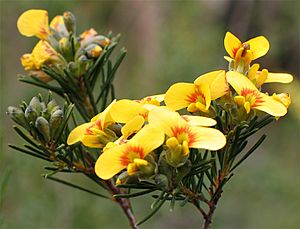Smooth parrot-pea facts for kids
Quick facts for kids Smooth parrot-pea |
|
|---|---|
 |
|
| Dillwynia glaberrima in Freycinet National Park | |
| Scientific classification | |
| Kingdom: | |
| (unranked): | |
| (unranked): | |
| (unranked): | |
| Order: | |
| Family: | |
| Genus: |
Dillwynia
|
| Species: |
D. glaberrima
|
| Binomial name | |
| Dillwynia glaberrima Sm.
|
|
| Synonyms | |
|
|
The Smooth Parrot-Pea, known scientifically as Dillwynia glaberrima, is a lovely plant from the pea family, called Fabaceae. It grows naturally in Australia. This plant gets its common name because its bright yellow flowers look a bit like the colorful feathers of a parrot.
Contents
About the Smooth Parrot-Pea
What It Looks Like
The Smooth Parrot-Pea is a type of shrub. It can grow up to 2 meters (about 6.5 feet) tall. It might spread out wide or grow straight up. Its leaves are shaped like thin tubes and can be up to 2.5 centimeters (about 1 inch) long. The tip of each leaf is usually short and curves backward.
The flowers are bright yellow and have red markings. They look like small pea flowers. These flowers grow in thick groups at the ends of the plant's thin, wiry branches. They usually appear from August to December, which is late winter to early summer in Australia. After the flowers, the plant grows small pods that are about 4 to 6 millimeters long and have a few hairs on them.
How It Was Named
The Smooth Parrot-Pea was first officially described by an English botanist named James Edward Smith. He wrote about it in a book called Annals of Botany in 1805. The very first plant specimen used to describe this species was collected near Port Jackson in Australia.
Where It Grows
You can find Dillwynia glaberrima growing in many different natural areas across Australia. It lives in woodlands, open forests, and areas with lots of heathland plants. It is very common along the coastal parts of Queensland, New South Wales, Victoria, Tasmania, and South Australia.
How to Grow It
If you want to grow a Smooth Parrot-Pea, it needs a spot with some light shade. It also needs soil that drains water well. This means the water should not sit around the plant's roots.

